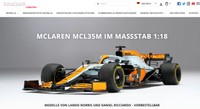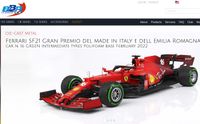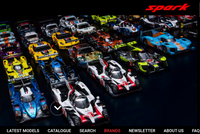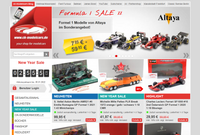Manufacturers from Asia
Eidai (Japan)
At the end of the seventies Eidai offered a series existing of nine Formula One models in 1:43 which were in competition with the Italian manufacturer Polistil and Yaxon. Although the Japanese were less common with their models in Europe, Eidai was clearly ahead in terms of quality – especially painting and packaging. Some models were quite unique. Such as the March 761B driven by Ian Scheckter in Rothmans colors. Or the six-wheel Tyrrell from 1977 as well as the red Imperial-Tobacco-Lotus 78 from Gunnar Nilsson which he drove in 1977 in his last Grand Prix. Almost exactly one year later the Swede died of the consequences of cancer. But also the rest of the field is well done and for those times of surprisingly high quality. With one expectation: The Wolf WR1 which won at its first race in Argentina 1977 was much more darker in original than the version Eidai presented. In addition to the 1:43 model Eidai also offered some models in 1:20. Such as the Lotus 78, Ferrari 312 T2, Brabham BT45B, Tyrrell P34/2 and McLaren M26. All these models were mounted with a working steering as well as detachable wheels. While the 1:43-cars were offered in darkblue cardboard boxes with blister windows the «Grip» models were sold in black cardboard boxes. Or, what is less common today, in blister packs with spare parts and mechanic figures. For modelbuilders with a lot of patience and skill Eidai also offered two 1:8 plastic kits: the Lotus 72D and the McLaren M23. The latter are traded around 1000 Euro. Therefore the models in 1:43 are a bargain. Mint boxed you can find them between 20 and 30 Euro. The 1:20-models are around four time more expensive. The series should have been continued by the way. The number GT61 and GT62, more precisely the Ligier-Matra JS7 and the Tyrrell 008, were already announced. But before these models could be produced the company from Tokyo closed its doors.
Eidai hat Ende der Siebzigerjahre mit einer Serie von neun F1-Miniaturen im Maßstab 1:43 der Konkurrenz von Polistil und Yaxon Paroli geboten. Zwar waren die Japaner mit ihren Modellen in Europa weniger weit verbreitet, in Sachen Qualität – vor allem punkto Lackierung und Verpackung – hatte Eidai aber klar die Nase vorn. Zu den etwas ausgefalleren Modellen zählen der March 761B von Ian Scheckter in Rothmans-Farben, der 77er Sechsrad-Tyrrell sowie der rote Imperial-Tobacco-Lotus 78 von Gunnar Nilsson, den er Schwede 1977 bei seinem letzten Grand Prix fuhr, ehe er fast auf den Tag genau ein Jahr später an den Folgen einer Krebserkrankung starb. Aber auch der Rest des Feldes lässt sich sehen und ist für damalige Zeiten von erstaunlich hoher Qualität. Allerdings sind die übrigen Modelle auch bei Polistil und/oder Yaxon erschienen. Einziger Wermutstropfen: Das tiefe Dunkelblau des auf Anhieb siegreichen Wolf WR1 hat Eidai ganz und gar nicht getroffen. Neben der 1:43er-Baugrösse setzte Eidai auch auf den Maßstab 1:20. Erschienen sind dort Lotus 78, Ferrari 312 T2, Brabham BT45B, Tyrrell P34/2 und McLaren M26. Die Modelle verfügen über eine funktionstüchtige Lenkung sowie abnehmbare Räder. Während die 1:43er in dunkelblauen Kartonboxen mit Blister-Fenster angeboten wurden, gelangten die «Grip»-Modelle in schwarzen Kartonschachteln in den Verkauf. Oder, was heute seltener anzutreffen ist, in Blister-Verpackungen mit Ersatzteilen und Mechaniker-Figuren. Für Modellbauer mit viel Geduld und zwei geschickten Händen gab es von Eidai auch zwei 1:8-Plastikbausätze: den Lotus 72D und den McLaren M23. Letztere werden um die 1000 Euro gehandelt. Dagegen sind die 1:43er wahre Schnäppchen. Mint boxed findet man sie zwischen 20 und 30 Euro. Gut das Vierfache kosten die 1:20er-Modelle. Wobei man die mit etwas Glück auch günstiger findet. Die Serie hätte übrigens fortgesetzt werden sollen. Mit der Nummer GT61 und GT62 waren bereits der Ligier-Matra JS7 und der Tyrrell 008 angekündigt. Doch bevor diese Modelle produziert werden konnten, ging die Firma aus Tokio ein.
Lucky Toys (Hong Kong)
Lucky Toys is one of numerous companies from Hong Kong that began to produce plastic-toys at the beginning of the sixties. Like most companies from the former British colony there are just a few details known about Lucky Toys. Catalogues or lists with item numbers are rare; information on packaging should be taken with caution. It is certain that Lucky Toys had various Formula One models with friction motors on the scale of approx. 1:28. A precise dating is impossibly to make. One can assume that the first Formula One cars of the company with the horseshoe in the lettering must have been appeared around 1965. One of the first must be the Ferrari 156, also known as «sharknose». The car, number 153, was fitted with a detachable engine cover. Just like No. 156, a Lotus. They must be from the same series. The numbers suggest that there are other racing cars in between. Research has shown that it must be a Cooper, a Porsche F2 and two sports cars (a Fiat Abarth and a Ferrari 813). The Cooper is also available as a «Pit Stop Set». In addition there are so called «Racing Sets» with three Formula One models. These sets are difficult to find. At the end of the sixties other models were added. Starting with the number 189, a Lola-Climax V8. Followed by the number 194, a green BRM. As well as number 193, an Alpine F3. All three also exists in sets with two figures and a winning trophy. Between number 189 and 193 no further Formula One models were listed in the catalogue at this time. It continues with the numbers 3016 (Honda), 3017 (Lotus) and 3019 (Cooper-Maserati).
«Real Lucky Toys from the sixties are rare.
And like other manufacturers from
Hong Kong it is the packaging that makes
the extra appeal.» f1modelcars.com
Almost all Formula One models have one thing in common: They have two flags behind the starting number on the nose of the car: a Union Jack flag and a black and white checkered flag. This may be important because there are apparently identical models/copies in other countries. For example: In Germany there was a company called F.I.A.M, in the USA one which was called ZEE. German models therefore wore a German flag (instead of the Union Jack), on the models for the American market you can find the famous «Stars&Stripes». This makes the models, often sparsely labeled on the underside, easier to identify. In the mid-seventies Lucky Toys created another series of motorized Formula 1 models. These included a Yardley McLaren M19A which Lucky Toys also presented as a Brabham in Martini painting. In addition there was a Ferrari 312B2 as well as a Tyrrell – presumably a type 007 which the Chinese also offered in Shadow-colours, means UOP and Embassy. Some of these models were offered as pit-stop dioramas in blister packs. Most of these plastic racers were copied from Corgi Toys. The price of Formula One models made by Lucky Toys is hard to determine. Demand is much lower than for die-cast models from the same time. Nevertheless you should not underestimate the value. Original packaging can be called up to 100 Euro. What I consider as too much. But one must not forget: Real Lucky Toys from the sixties are rare. Especially mint boxed. And like most other Hong Kong manufacturers it is the packaging that makes the extra appeal.
Lucky Toys ist eines von zahlreichen Unternehmen aus Hong Kong, das Anfang der Sechzigerjahre Spielzeug aus Plastik und Plüsch zu produzieren begann. Wie über die meisten Firmen aus der ehemaligen britischen Kolonie ist auch über Lucky Toys nicht viel in Erfahrung zu bringen. Kataloge oder Listen mit Artikelnummern sind rar; Angaben auf Verpackungen sollten mit Vorsicht genossen werden. Sicher ist, dass es von Lucky Toys diverse Formel-1-Modelle mit Friktionsmotoren im Massstab von ca. 1:28 gab. Eine genaue Datierung ist kaum auszumachen. Anhand der Modelle kann man davon ausgehen, dass die F1-Renner der Firma mit dem Hufeisen im Schriftzug frühestens ab Mitte der Sechzigerjahre erschienen sind. Einer der ersten wird der Ferrari 156, auch «Sharknose» genannt, gewesen sein. Der als Nummer 153 gekennzeichnete Wagen gab es mit abnehmbarer Motorhaube. Genauso wie die Nr. 156, ein Lotus. Anhand ihrer Verpackungen müssen die beiden aus derselben Serie stammen. Die Nummern lassen vermuten, dass es dazwischen noch andere Rennwagen gibt. Recherchen haben ergeben, dass es sich dabei um einen Cooper, einen Porsche F2 und zwei Sportwagen (einen Fiat Abarth und einen Ferrari 813) handelt. Den Cooper gibt es auch als «Pit Stop Set». Ausserdem existieren so genannte «Racing Sets» mit drei Lucky-Toys-F1-Boliden. Diese sind wie das Boxenstopp-Modell sehr selten anzutreffen. Ende der Sechzigerjahre kamen weitere GP-Modelle dazu. Angefangen bei der Nummer 189, einem Lola-Climax V8. Gefolgt von der Nummer 194, einem dunkelgrünen BRM. Auch die 193, der Alpine F3, hatte ihr Vorbild im Formelsport. Alle drei Rennwagen legte Lucky Toys auch in Sets mit zwei Figuren und einem Siegerpokal auf. Ob zwischen den Nummern 189 und 193 noch weitere Formel-1-Autos im Sortiment waren, mag ich bezweifeln. Im zu dieser Zeit erschienenen Katalog waren keine weiteren Modelle aufgeführt. Weiter ging es erst mit den Nummern 3016 (Honda), 3017 (Lotus) und 3019 (Cooper-Maserati).
«Echte Lucky Toys aus den Sechzigerjahren sind rar.
Und wie bei den meisten anderen Herstellern aus
Hong Kong sind es gerade die Verpackungen,
die den Reiz ausmachen.» f1modelcars.com
Fast allen Lucky-Toys-F1-Modellen ist eines gemein: Sie haben auf der Schnauze, direkt hinter der Startnummer, zwei Flaggen: eine Union-Jack-Fahne sowie eine schwarz-weiss karierte Zielflagge. Das ist insofern von Bedeutung, als dass es offenbar identische Modelle/Kopien in anderen Ländern gab. In Deutschland war dies die Firma F.I.A.M, in den USA ein Unternehmen namens ZEE. Deutsche Modelle trugen deshalb eine deutsche Flagge (anstelle der Union Jack), auf den Modellen für den amerikanischen Markt findet man «Stars&Stripes». Das lässt die auf der Unterseite oft spärlich beschrifteten Modelle etwas leichter zuordnen. Mitte der Siebzigerjahre legte Lucky Toys eine weitere Serie mit motorisierten Formel-1-Modellen nach. Dazu gehörten ein Yardley McLaren M19A, den Lucky Toys auch als Brabham in Martini-Lackierung auflegte. Ausserdem gab es einen Ferrari 312B2 sowie einen Tyrrell – vermutlich vom Typ 007, den die Chinesen auch in Shadow-Farben, sprich UOP und Embassy ins Spielzeug-Regal stellten. Einige dieser Modelle wurden als Pit-Stop-Dioramen in Blister-Verpackungen angeboten. Abgekupfert wurden die meisten dieser Plastik-Renner bei Corgi Toys. Der Preis von F1-Modellen made by Lucky Toys ist schwer festzulegen. Die Nachfrage ist deutlich geringer als bei Die-Cast-Modellen aus derselben Zeit. Trotzdem sollte man den Wert nicht unterschätzen. Originalverpackt können Preise von bis zu 100 Euro aufgerufen werden. Was ich für übertrieben halte. Aber man darf nicht vergessen: Echte Lucky Toys aus den Sechzigern sind rar. Erst recht mint boxed. Und wie bei den meisten anderen Herstellern aus Hong Kong sind es gerade die Verpackungen, die den Reiz ausmachen.
Tomica (Japan)
Zylmex (Hong Kong)
Zylmex was one of many companies who tried to copy «Hotwheels». Therefore it is not a big surprise that the company from Hong Kong which was called originally Zyll Enterprises also had a subsidiaries in the USA. The products from Zylmex and ZEE, the US-based company in Long Beach, were therefore very identical. With one difference: Zylmex had a bigger assortments of modelcars than ZEE which began to produce only at the end of the sixties. Referring to «Hotwheels» Zylmex started its production with a series of modelcars in 1:64. Like the «Hotwheels» they should have smoothly axles. But the company from Hong Kong didn't really put that into action. Anyway the D-series became iconic. The models from D1 to D8 were available in several countries – especially in the USA and in Great Britain. Which can be seen through different packaging. Modelcars made by Zylmex in the UK were distributed by the oil-company Texaco. They were called «Texaco Scorchers». In the USA they were named simple «Racing Cars». In Germany the were sold as «Flitzer». The first series included the following models: BRM V8 (D1), Ferrari (D2), Cooper-Maserati (D3), Eagle (D4), Brabham-Repco (D5), Lotus-Climax (D6), McLaren (D7) and BRM H16 (D8).
«Nowadays the US-company sells swimming-pools.» f1modelcars.com
This selection reminds me very much of the modelcars made by Penny. And Zylmex even got further. Like the Italians they produced a second series. This time with the numbers D27 to D34. As distinct from the first series it seems that there are no copies from the second series. There are only some modified packaging. For a collector it is easy to separate the two series. Every model from the second series is fitted with a rearwing. What makes them also slightly different to the modelcars made by Penny. The second series at a glance: Honda (D27), Ferrari (D28), Lotus (D29), McLaren (D30), Matra (D31), Repco (D32), Lotus (D33) and Ferrari (D34). The Repco clearly seems to be a Brabham-Repco. I don't know why Zylmex used the name of the engine manufacturer instead of the team. I guess the «D» in both series is a shortcut for «dart». Which would explain the purpose of Zylmex: They wanted to sell modelcars which are as quick as a dart. Or at least quicker than the «Hotweels». There were also normal streetcars in the «Dart-Wheelers»-series. Like the Formula One cars they were painted loud and colourful. But not everything at Zylmex was arisen from the fantasia. For example: D27 (Honda) and D28 (Ferrari) are both quite nice modelcars. In the seventies Zylmex produced some more Formula One models. This time in a larger scale (around 1:24). The six cars were called K701 («Super Scop» – a Ferrari with #1), K702 («Super Speed» – looks like a Honda), K703 («Super Drag» – a blue Matra), K707 (a Tyrrell-Ford), K708 (a Lotus 72) and a K709 (a Ferrari 312). According to web-sources Zylmex stopped its production in 1996. Also ZEE was sold – to a company called Intex Corp. Which nowadays sells swimming-pools. Zylmex-and ZEE-modelcars are not highly dealt. A simple item in 1:64 costs rarely more than 10 Euro. A whole series is more precious. Prices between 100 and 120 Euro are not unusual.
Das Vorbild von Zylmex hiess «Hotwheels». Und daher erstaunt es auch nicht, dass die als Zyll Enterprises in Hong Kong gegründete Firma einen Ableger in den USA machte. Die Produkte von Zylmex und ZEE Toys, der Firma in Long Beach, sind demzufolge sehr identisch. Wobei das Sortiment von Zylmex umfassender war. Und ZEE Toys erst ab Ende der Sechzigerjahre Modelle, meistens mit Friktionsantrieb, vom Stapel liess. In Anlehnung an «Hotwheels» produzierte Zylmex die ersten Modelle in 1:64. Wie die Vorbilder aus den USA sollten sie über möglichst reibungsfreie Achsen verfügen. Ganz gelungen ist das den Mannen aus Hong Kong nicht. Dennoch erreichte die D-Serie Kultstatus. In verschiedenen Ländern wurden die Nummern D1 bis D8 aufgelegt – allen voran in den USA und Grossbritannien. Diverse verschiedene Verpackungen zeugen davon. Die Modelle im United Kingdom wurden durch Mineralölhersteller Texaco vertrieben. Daher der Name «Texaco Scorchers». In den USA waren so genannte «Racing Cars» am Start. In Deutschland erhielten die 1:64er den Namen «Flitzer». Zu den acht Erstlingen zählen: BRM V8 (D1), Ferrari (D2), Cooper-Maserati (D3), Eagle (D4), Brabham-Repco (D5), Lotus-Climax (D6), McLaren (D7) und BRM H16 (D8).
«Heute stellt die Firma Swimming-Pools her.» f1modelcars.com
Damit ist auch der Ursprung der F1-Boliden made by Zylmex geklärt. Die Chinesen hatten bei Penny/Politoys abgekupfert. Deshalb erstaunt es auch nicht, dass Zylmex in einer zweiten Phase (wie Penny) nochmals acht Stück produzierte. Diesmal mit den Nummern D27 bis D34. Im Unterschied zur ersten Serie gibt es von der zweiten keine Kopien. Lediglich andere Verpackungen. Für Sammler ist es ein Leichtes, die beiden Modellreihen auseinanderzuhalten – auch ohne die Nummern zu kennen. Die Autos der zweiten Serie, also D27 bis D34, wurden allesamt mit Heckspoilern ausgerüstet. Damit unterscheidet sie sich auch klar von Auflage 2 bei den Penny-Modellen. Die Modelle D27 bis D34 im Überblick: Honda (D27), Ferrari (D28), Lotus (D29), McLaren (D30), Matra (D31), Repco (D32), Lotus (D33) und Ferrari (D34). Beim Repco handelt es sich um einen Brabham. Warum Zylmex in diesem Fall den Motoren- und nicht den Chassishersteller nannte, ist mir nicht bekannt. Das «D» in der Bezeichnung dürfte in beiden Seien von «dart», zu Deutsch Pfeil, stammen. Was die Absicht von Zylmex unterstreicht: Die Modelle sollten mindestens so schnell sein wie Pfeile. Sicher schneller aber als die «Hotwheels». Von den «Dart-Wheelers» gab es auch «normale» Strassenfahrzeuge. Zylmex lackierte auch die ziemlich grell und bunt. Dennoch ist nicht alles der Fantasie entsprungen. Der D27 (Honda) und der D28 (Ferrari) sind nicht nur farblich ganz gut getroffen. In den Siebzigerjahren legte Zylmex sechs F1-Modelle in einem grösseren Massstab nach (ca. 1:24). Die Modelle trugen die Bezeichnungen K701 («Super Scop» – ein Ferrari mit der Startnummer 1), K702 («Super Speed» – ein getarnter Honda), K703 («Super Drag» – ein blauer Matra), K707 (ein Tyrrell-Ford), K708 (ein Lotus 72) und K709 (ein Ferrari 312). Internetberichten zufolge stellte Zylmex 1996 den Betrieb ein. Auch ZEE Toys wurde verkauft – an die Intex Corp. Diese stellt heute Swimming-Pools her. Die Preise für Zylmex- und ZEE-Modelle sind bis heute bescheiden geblieben. Einzelne Modelle werden selten über 10 Euro gehandelt. Für eine komplette Serie der D-Modelle muss man 100 bis 120 Euro rechnen.















